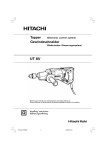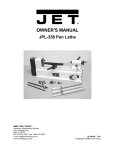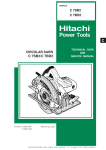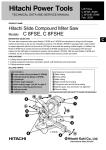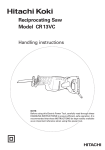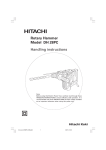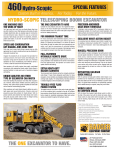Download Makita VTP-16A Specifications
Transcript
Impact Drill Model VTP-16A • VTV-16 Handling instructions VTV-16 Note: Before using this Electric Power Tool, carefully read through these HANDLING INSTRUCTIONS to ensure efficient, safe operation. It is recommended that these INSTRUCTIONS be kept readily available as an important reference when using this power tool. 000Book_VTP-16A.indb 1 2009/06/24 11:43:30 GENERAL SAFETY RULES WARNING! Read all instructions Failure to follow all instructions listed below may result in electric shock, fire and/or serious injury. The term “power tool” in all of the warnings listed below refers to your mains operated (corded) power tool or battery operated (cordless) power tool. SAVE THESE INSTRUCTIONS 1) Work area a) Keep work area clean and well lit. Cluttered and dark areas invite accidents. b) Do not operate power tools in explosive atmospheres, such as in the presence of flammable liquids, gases or dust. Power tools create sparks which may ignite the dust of fumes. c) Keep children and bystanders away while operating a power tool. Distractions can cause you to lose control. 2) Electrical safety a) Power tool plugs must match the outlet. Never modify the plug in any way. Do not use any adapter plugs with earthed (grounded) power tools. Unmodified plugs and matching outlets will reduce risk of electric shock. b) Avoid body contact with earthed or grounded surfaces such as pipes, radiators, ranges and refrigerators. There is an increased risk of electric shock if your body is earthed or grounded. c) Do not expose power tools to rain or wet conditions. Water entering a power tool will increase the risk of electric shock. d) Do not abuse the cord. Never use the cord for carrying, pulling or unplugging the power tool. Keep cord away from heat, oil, sharp edges or moving parts. Damaged or entangled cords increase the risk of electric shock. e) When operating a power tool outdoors, use an extension cord suitable for outdoor use. Use of a cord suitable for outdoor use reduces the risk of electric shock. f) Recommendation for the use of residual current device with a rated residual current of 30mA or less. 3) Personal safety a) Stay alert, watch what you are doing and use common sense when operating a power tool. Do not use a power tool while you are tired or under the influence of drugs, alcohol or medication. A moment of inattention while operating power tools may result in serious personal injury. b) Use safety equipment. Always wear eye protection. Safety equipment such as dust mask, non-skid safety shoes, hard hat, or hearing protection used for appropriate conditions will reduce personal injuries. c) Avoid accidental starting. Ensure the switch is in the off position before plugging in. Carrying power tools with your finger on the switch or plugging in power tools that have the switch on invites accidents. 2 000Book_VTP-16A.indb 2 d) Remove any adjusting key or wrench before turning the power tool on. A wrench or a key left attached to a rotating part of the power tool may result in personal injury. e) Do not overreach. Keep proper footing and balance at all times. This enables better control of the power tool in unexpected situations. f) Dress properly. Do not wear loose clothing or jewellery. Keep your hair, clothing and gloves away from moving parts. Loose clothes, jewellery or long hair can be caught in moving parts. g) If devices are provided for the connection of dust extraction and collection facilities, ensure these are connected and properly used. Use of these devices can reduce dust related hazards. 4) Power tool use and care a) Do not force the power tool. Use the correct power tool for your application. The correct power tool will do the job better and safer at the rate for which it was designed. b) Do not use the power tool if the switch does not turn it on and off. Any power tool that cannot be controlled with the switch is dangerous and must be repaired. c) Disconnect the plug from the power source before making any adjustments, changing accessories, or storing power tools. Such preventive safety measures reduce the risk of starting the power tool accidentally. d) Store idle power tools out of the reach of children and do not allow persons unfamiliar with the power tool or these instructions to operate the power tool. Power tools are dangerous in the hands of untrained users. e) Maintain power tools. Check for misalignment or binding of moving parts, breakage of parts and any other condition that may affect the power tools’ operation. If damaged, have the power tool repaired before use. Many accidents are caused by poorly maintained power tools. f) Keep cutting tools sharp and clean. Properly maintained cutting tools with sharp cutting edges are less likely to bind and are easier to control. g) Use the power tool, accessories and tool bits etc., in accordance with these instructions and in the manner intended for the particular type of power tool, taking into account the working conditions and the work to be performed. Use of the power tool for operations different from intended could result in a hazardous situation. 5) Service a) Have your power tool serviced by a qualified repair person using only identical replacement parts. This will ensure that the safety of the power tool is maintained. PRECAUTION Keep children and infirm persons away. When not in use, tools should be stored out of reach of children and infirm persons. 2009/06/24 11:43:31 IMPACT DRILL SAFETY WARNINGS 1. Wear ear protectors with impact drills. Exposure to noise can cause hearing loss. 2. Use auxiliary handles supplied with the tool. Loss of control can cause personal injury. 3. Before drilling into a wall, floor or ceiling, thoroughly confirm that no items such as electric cables or conduits are buried inside. SPECIFICATIONS Model VTP-16A Voltage (by areas)* VTV-16 (110V, 115V, 120V, 127V, 220V, 230V, 240V) Power input 800 W* Speed change 1 2 3 4 No load speed 700/min 1400/min 0-700/min 0-1400/min Capacity Steel 16 mm 10 mm 16 mm 10 mm Concrete 35 mm 16 mm 35 mm 16 mm Weight (without cord) 3.8 kg * Be sure to check the nameplate on product as it is subject to change by areas. STANDARD ACCESSORIES (1) Chuck wrench .............................................................. 1 (2) Side handle .................................................................. 1 (3) Depth stopper............................................................... 1 Standard accessories are subject to change without notice. OPTIONAL ACCESSORIES (sold separately) ○ Drill Bit for concrete O.D Length 6.5mm 100mm Code No. 931851 8.0 100 931852 9.5 120 931853 10.0 120 931854 12.0 160 971704 13.0 160 931855 931776 14.3 160 16.0 160 971670 19.0 160 931856 Optional accessories are subject to change without notice. APPLICATIONS ○ By combined actions of ROTATION and IMPACT: Boring holes in hard materials (concrete, marble, granite, tiles, etc.) ○ By ROTATIONAL action: Boring holes in metal, wood and plastic. PRIOR TO OPERATION 1. Power source Ensure that the power source to be utilized conforms to the power requirements specified on the product nameplate. 000Book_VTP-16A.indb 3 2. Power switch Ensure that the power switch is in the OFF position. If the plug is connected to a receptacle while the power switch is in the ON position, the power tool will start operating immediately, inviting serious accident. 3. Extension cord When the work area is removed from the power source, use an extension cord of sufficient thickness and rated capacity. The extension cord should be kept as short as practicable. 4. Fitting the drill bit Fit the drill bit into the chuck and use the chuck wrench to secure it, tightening the chuck by each of the three holes in turn. 5. Selecting the appropriate drill bit ○ When boring concrete or stone Use the drill bits specified in the Optional Accessories. ○ When boring metal or plastic Use an ordinary metalworking drill bit. ○ When boring wood Use an ordinary woodworking drill bit. However, when drilling 6.5 mm or smaller holes, use a metalworking drill bit. 6. High-speed/Low-speed changeover: Prior to changing speed, ensure that the switch is in the OFF position, and the drill has come to a complete stop. To change speed, depress the shift Iock and slide it in the appropriate direction, as indicated by the arrow in Fig. 1. The numeral “1” engraved in the drill body denotes low speed, the numeral “2” denotes high speed. Gear cover 1 2 Shift lock (push and slide) Fig. 1 3 2009/06/24 11:43:31 7. IMPACT to ROTATION changeover: (Fig. 2) The Impact Drill can be switched from IMPACT (impact plus rotation) to ROTATION (rotation only) by simply turning the change ring. When boring concrete, stone, tile or similar hard materials, turn the change ring fully clockwise. The drill head impacts against the material while continuing to rotate. When boring metal, wood or plastic, turn the change ring fully counterclockwise. The drill simply rotates as an ordinary electric drill. Change ring Gear cover Rotation Rotation + impact 1 2 Fig. 2 CAUTION Do not use the Impact Drill in the IMPACT function if the material can be bored by rotation only. Such action will not only reduce drill efficiency, but may also damage the drill tip. When changing over, ensure that the change ring is turned as far as it will go. 8. Fixing the side handle. Loosen the glip on the side handle, and attach the side handle to the gear cover in a position convenient for drilling. Match the projecting part of the handle to the groove on the gear cover, and firmly tighten the glip. To remove the side handle, loosen the glip, and rotate the handle. To attach a depth stopper on the side handle, insert the stopper into the hexagon hole groove on the side handle, adjust the position of the depth stopper in accordance with the desired depth of the hole, and firmly tighten the glip. PRACTICAL HANDLING PROCEDURES 1. Pressure: Drilling will NOT be accelerated by placing heavy pressure on the drill. Such action will only result in a damaged drill bit, decreased drilling efficiency and/or shortened service life of the drill. 2. Using a large diameter drill bit: The larger the drill bit diameter, the larger the reactive force on your arm. Be careful not to lose control of the drill because of this reactive force. To maintain firm control, establish a good foothold, hold the drill tightly with both hands, and ensure that the drill is vertical to the material being drilled. 3. When drilling completely through the material: When the drill bit bores completely through the material, careless handling often results in a broken drill bit or damage to the drill body itself due to the sudden movement of the drill. Always be alert and ready to release the pushing force when drilling through the material. 4. Switch operation: (1) VTP-16A: By pulling the trigger switch and depressing the stopper, the switch is held in the ON position for continuous operation. To turn the drill OFF, pull the trigger switch again and release. (2) VTV-16: The rotational speed of the drill bit can be controlled by varying the amount that the trigger switch is pulled. Speed is low when the trigger switch is pulled slightly and increases as the switch is pulled more. Continuous operation may be attained by pulling the trigger switch and depressing the stopper. To turn the switch OFF, pull the trigger switch again to disengage the stopper, and release the trigger switch to its original position. 5. Precautions on boring The drill may become overheated during operation; however, it is sufficiently operable. Do not cool the drill bit in water or oil. 6. Caution concerning immediately after use Immediately after use, while it is still revolving, if the Drill is placed on a location where considerable ground chips and dust have accumulated, dust may occasionally be absorbed into the Drill mechanism. Always pay attention to this possibility. MAINTENANCE AND INSPECTION 1. Inspection the drill bit Continued use of a worn and/or damaged drill bit will result in reduced drilling efficiency and may seriously overload the drill motor. Inspect the drill bit often and replace it with a new bit as necessary. 2. Inspecting the mounting screws Regularly inspect all mounting screws and ensure that they are properly tightened. Should any of the screws be loose, retighten them immediately. Failure to do so could result in serious hazard. 3. Inspecting the carbon brushes (Fig. 3) The Motor employs carbon brushes which are consumable parts. When they become worn to or near the “wear limit”, it could result in motor trouble. When an auto-stop carbon brush is equipped, the motor will stop automatically. At that time, replace both carbon brushes with new ones which have the same carbon brush Numbers shown in the figure. In addition, always keep carbon brushes clean and ensure that they slide freely within the brush holders. Wear limit b mm No. of carbon brush a mm No. of carbon brush a b 43 17 6 Usual carbon brush 73 17 7 Auto-stop carbon brush Fig. 3 4 000Book_VTP-16A.indb 4 2009/06/24 11:43:31 4. Replacing carbon brushes Disassemble the brush caps with a slotted-head screwdriver. The carbon brushes can then be easily removed. 5. Maintenance of the motor The motor unit winding is the very “heart” of the power tool. Exercise due care to ensure the winding does not become damaged and/or wet with oil or water. 6. Replacing supply cord If the supply cord of Tool is damaged, the Tool must be returned to Hitachi Authorized Service Center for the cord to be replaced. 7. Service parts list A: Item No. B: Code No. C: No. Used D: Remarks CAUTION Repair, modification and inspection of Hitachi Power Tools must be carried out by an Authorized Service Center. This Parts List will be helpful if presented with the power tool to the Authorized Service Center when requesting repair or other maintenance. In the operation and maintenance of power tools, the safety regulations and standards prescribed in each country must be observed. MODIFICATIONS Hitachi Power Tools are constantly being improved and modified to incorporate the latest technological advancements. Accordingly, some parts (i.e. code numbers and/or design) may be changed without prior notice. NOTE Due to HITACHI’s continuing program of research and development, the specifications herein are subject to change without prior notice. 5 000Book_VTP-16A.indb 5 2009/06/24 11:43:31 6 000Book_VTP-16A.indb 6 2009/06/24 11:43:31 B 930733 950284 981566 876319 981568 971657 939556 981572 6003VV 981592 981571 980717 971736 939543 981564 971661 981573 608VVM 981570 949454 955912 942864 981574 981575 981576 981577 981569 981581 609VVM 981585 981588 981611C 981611E 981611F 991007 930703 981610C 981610E 981610F 981610G 981610H 981610J –––––– A 1 2 3 4 5 6 7 8 9 10A 12 13 14 15 16 17 18 19 20 21 22 23 24 25 26 27A 28 29 30 31 32 33-1 33-2 33-3 35A 36 37-1 37-2 37-3 37-4 37-5 37-6 39 VTP-16A 1 1 1 1 C 1 1 1 1 1 1 1 1 1 1 1 1 1 1 1 1 1 3 1 6 4 1 1 1 1 1 1 1 1 1 1 1 1 1 2 2 1 1 1 110V-127V “36” 220V-230V “36” 240V “36” 220V-230V “36” “FRA, ITA, GBR” 240V “36” “AUS” 110V “36” “GBR” M5 × 16 110V-127V 220V-230V 240V D5 × 60 “19, 30-32” 609VVC2PS2L M5 M5 D5 × 45 M5 608VVC2PS2L S-38 6003VVCMPS2L S-14 D 13G 16WL “1” A 40 41A 42 43 44 45A 46 47A 48 49 50 51 52 53 54 55 56 57 58 59 60-1 60-2 61 63 63A 500 501 502 503 B 961781 999073 981586 981560 981562 984367 946362 994273 930153 971667Z 949365 957561 959140 956384 949423 981578 981373 938108 954004 960266 953327 938051 –––––– 981500 986277 931844 981579 981580 983987 C 2 2 2 1 1 1 1 1 1 1 2 1 1 5 6 1 2 1 2 1 1 1 1 1 1 1 1 1 1 “502, 503” “EUROPE, AUS” “NZL, GBR, SAF” D8.8 D10.1 D4 × 16 D4 × 20 M4 M4 × 5 “42, 50” D 7 000Book_VTP-16A.indb 7 2009/06/24 11:43:31 B 930733 950284 981566 876319 981568 971657 939556 981572 6003VV 981592 981571 980717 971736 939543 981564 971661 981573 608VVM 981570 949424 983981 942864 981574 981575 981576 981577 981569 981581 609VVM 981585 981588 981611E 981611F 991007 930703 971720G 981610H 980945E 980945F –––––– 961781 999073 A 1 2 3 4 5 6 7 8 9 10A 12 13 14 15 16 17 18 19 20 21 22 23 24 25 26 27A 28 29 30 31 32 33-1 33-2 35A 36 37A-1 37A-2 37A-3 37A-4 38 39 40A VTV-16 1 1 1 1 2 2 C 1 1 1 1 1 1 1 1 1 1 1 1 1 1 1 1 1 3 1 4 4 1 1 1 1 1 1 1 1 1 3 1 1 2 2 1 220V “36” “SAF, GBR, HOL, AUT, SUI, FRG, FRA” 240V “36” “AUS” 220V-230V “36” 240V “36” M5 × 16 220V-230V 240V D5 × 60 “19, 30-32” 609VVC2PS2L M5 M5 D5 × 45 M5 608VVC2PS2L S-38 6003VVCMPS2L S-14 D 13G 16WL “1” B 981586 982320Z 981562 984367 946362 994273 930153 318344 949365 957561 959141 982095 324722 324901 938108 981373 930446 960266 930793 953327 938051 –––––– 986277 955908 931844 981579 981580 983987 A 41 42 43 44A 45 46 47 48A 49 50 51 52 53A-1 53A-2 54 57 58 59 60 61-1 61-2 62 63 64 500 501 502 503 1 1 2 1 1 1 1 1 1 1 1 1 1 1 C 2 1 1 1 1 1 1 1 2 1 1 5 1 1 “502, 503” “SUI” “NZL” D8.8 D10.1 D4 × 16 “GBR(230V), SAF, SUI” D4 × 20 M4 × 5 “41, 49” D Hitachi Koki Co., Ltd. Shinagawa Intercity Tower A, 15-1, Konan 2-chome, Minato-ku, Tokyo, Japan 911 Code No. C99013611 N Printed in Japan 000Book_VTP-16A.indb 8 2009/06/24 11:43:31








